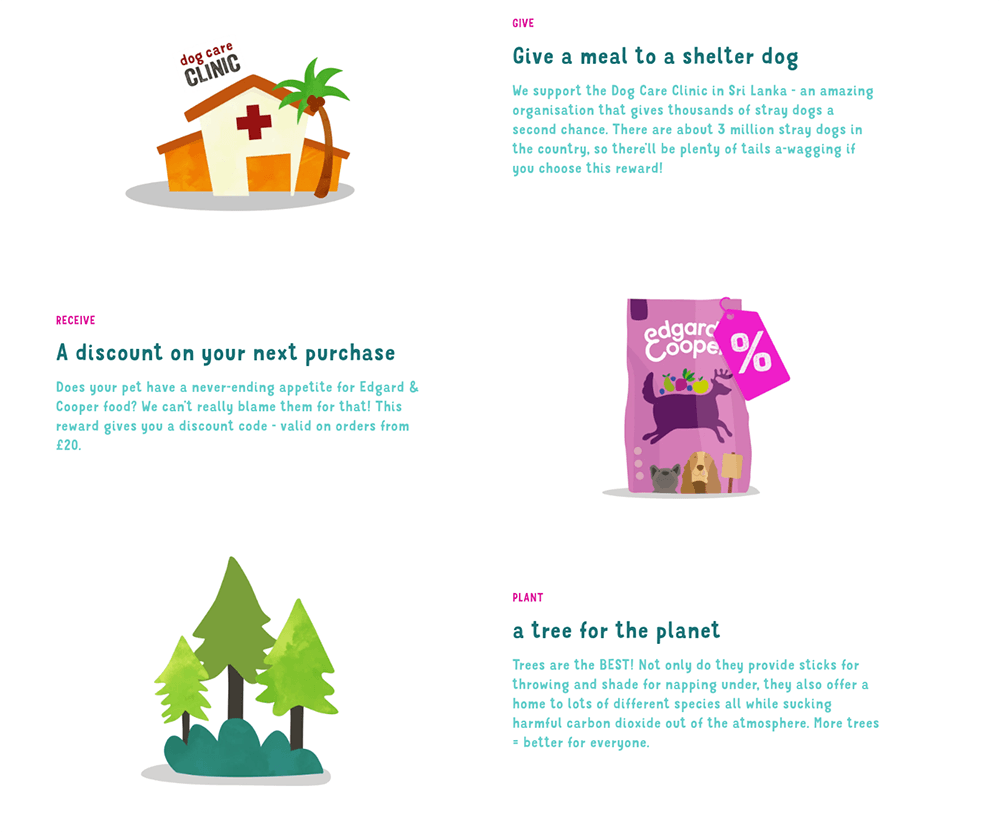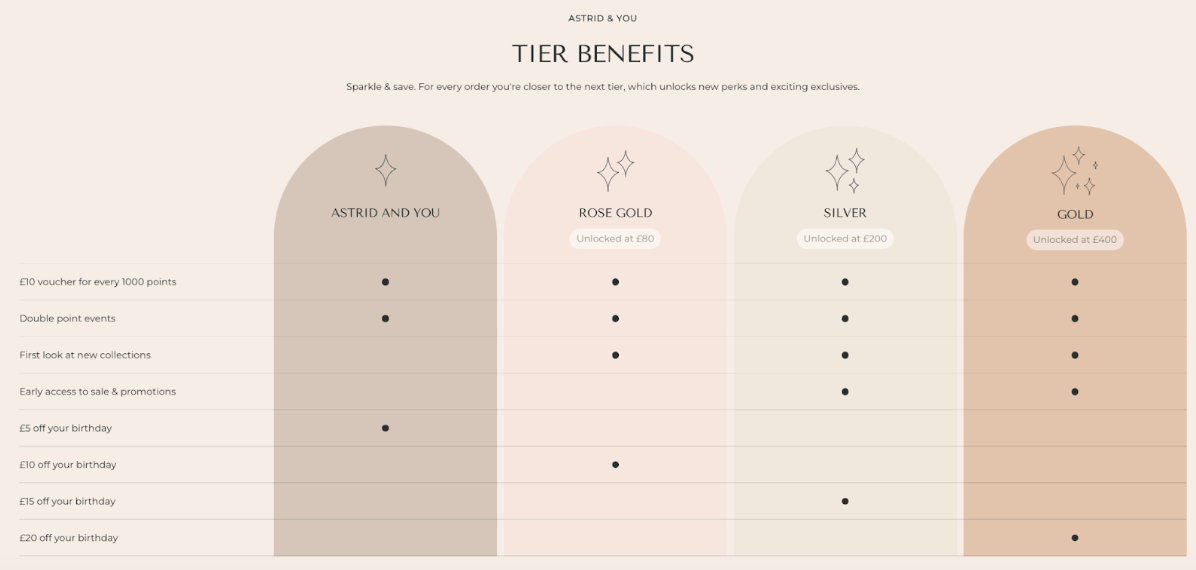Like a lot of people in the world (particularly in the US and the UK), I’m a part of quite a few loyalty programs — some I actually use regularly, and several others that are… Just there.
So, what are some of the factors that compel customers like me to not only sign up for a loyalty program but to actively use it?
Turns out, there’s quite a bit of research out there on this topic, and active engagement with a loyalty program comes down to roughly five core factors:
- Personalization;
- Proactive communication;
- Aligned values;
- Flexible/varied rewards; and
- A great customer experience.
In this article, we’ll look at these in more detail and look at actionable steps you can take with your Shopify store to drive success against those factors. But first, there’s a big question we need to ask.
Do customers want and use loyalty programs?
Spoiler alert: yes. Customers do want and use loyalty programs.
Firstly, the evidence is pretty strong. Secondly, the use of loyalty programs is very widespread — if customers didn’t want them, there wouldn’t be so many businesses creating them. Lastly, if the answer was no, there wouldn’t be anything else to say and the article would end here.
However, since we are here, let’s take a look at some of the research we’ve gathered that suggests customers do, in fact, want and use loyalty programs. Of course, I’ve highlighted some of LoyaltyLion’s own research here.
Here are some supporting statistics:
- Loyalty program members spend, on average, up to 40% more than customers who aren’t loyalty program members. (LoyaltyLion)
- When redeeming their rewards, loyalty program members spend up to 164% more than non-loyalty members. (LoyaltyLion)
- A customer who joins your loyalty program is 47% more likely to make a second purchase than a customer who doesn’t. (LoyaltyLion)
- 9 out of 10 loyalty program owners reported a positive ROI, and their average ROI is 4.8x. (Antavo)
These statistics show that not only do customers use loyalty programs, but they also spend more and are more likely to become repeat buyers.
Since we’ve answered that question, let’s move on to those factors I mentioned in the introduction.
1. Customers want personalization
Imagine this:
You’ve bought some products from a brand that caught your interest, and you think you’re probably going to buy from them again. Going back to their website, you notice the brand has a loyalty program and think, “Why not? I’m going to buy more stuff anyway, might as well get rewards for it.”
You sign up for the program and the first email you receive is addressed as “Dear Customer” (cue sick/cringe emoji). Maybe you let it go this time, even though you gave them your name when you signed up, it’s no biggie, right?
But further down the line, the brand starts recommending products you’ve never bought, have very little to do with previous purchases, and have no interest in. At this point, you’re probably annoyed just enough to unsubscribe to their emails, and the brand likely never hears from you again.
In that scenario, the key missing ingredient was personalization. Brands can’t ignore it. When they do, they may well find that their loyalty programs don’t perform as they expect.
Here are some statistics that support this point:
- 70% of customers say they would be loyal to a brand if they got personalized offers. (LoyaltyLion)
- 82% would share some type of personal data for a better customer experience. (PWC)
- 45% of Gen Z and Millennials said they wanted personalized product recommendations (this changes to 40% for Gen X and 32% for Boomers). (Klarna)
- 71% of consumers expect personalization. (McKinsey & Company)
So, how do you double check you’re delivering personalized experiences within your loyalty program?
Firstly, make sure you’ve set up your email marketing to address customers by name and not a generic term like “customer”.
Next, review your email segmentation to make sure it’s appropriate and accurate. If you find that your email segmentation is quite broad, you can use your loyalty program to get zero-party data to make more specific segments in two ways:
- Encourage customers to complete an online profile with useful information specific to your products, e.g., clothing sizes, skin types, allergies, hair types, and pet types.
- Incentivize them to complete quizzes that give you insight into their lifestyle and preferences —Esmi Skin does a good job of this with their skin quiz.
2. Customers want proactive communication
Now, we’re not talking about sending your customers multiple emails or messages a day — that would more likely annoy them. However, loyalty program members like myself would like to know the status of our loyalty program earnings/rewards before we lose out on any opportunities.
For example, I’m a loyalty program member of Protein Works, a fitness supplement brand. The brand regularly sends me “exclusive member discount” deals via SMS and email, but they rarely ever tell me about my points — and last year I realized all the points I’d accumulated throughout the year had expired before I had a chance to use them.
A single text or email to tell me that my points were about to expire would have spurred me to buy a bunch of products and redeem my points — and I’m not alone.
Here are supporting statistics:
- 56% of global consumers said that “they [brands] work hard to build a relationship with me” as a key factor in keeping them loyal to their favorite brand. (Marigold)
- 58% of consumers said they’re more likely to make a purchase from a business if they’ve subscribed to their texts, and 47% agreed that they feel more connected to businesses that send them text messages while 38% were neutral on this. (EZTexting)
- 35% of consumers say their most popular channel for receiving promotional messages is email. (Fresh Relevance)
- Of the top ten drivers of loyalty among US consumers surveyed by Bond, “Reps proactively address my needs” is in the fifth position.
These statistics tell us that customers prioritize brands that communicate effectively with them, and you can use your loyalty program data to facilitate that.
The easiest way to do so is by using an integration between your email service provider (ESP) or SMS provider and your loyalty program and setting up trigger sequences that notify customers about the status of their loyalty program.
For example, with LoyaltyLion, you can use integrations with ESPs such as Klaviyo, MailChimp, HubSpot, Omnisend, and more, as well as integrations with SMS providers Attentive and Voyage.
3. Customers want to see your values align with theirs
Customers are using their wallets to help them express their personal values — whether it’s a social, animal welfare, or environmental cause, they want to know that their spending isn’t just utilitarian.
Not only that, many customers will specifically look for brands that align with their values and spend their money there.
Here are the supporting statistics:
- Two out of three US consumers told researchers that social values now shape their shopping choices. (McKinsey & Company)
- Purpose-driven consumers, who choose products and brands based on how well they align to their values, now represent the largest segment (44%) of consumers. (IBM)
- One in ten consumers will make a purchase decision based on carbon footprint data availability, and 69% of consumers value practices that produce sustainable packaging and products. (Deloitte)
- 68% of customers say they would be loyal to a brand if it shared their values.
So, what can you do with your loyalty program that highlights your brand values and attracts customers of similar values?
One method is allowing your customers to donate the value of their points towards a relevant charitable cause. One brand that does this well is Edgard & Cooper, a pet food brand that lets you donate points to give a meal to a shelter dog or plant a tree.

4. Customers want more than simple discounts for rewards
Discounts have their place, sure, but for long-term relationship building with program members, brands need to do more than that. Customers like having a variety of options when it comes to reward redemption.
Here are some more supporting statistics:
- Over three-quarters of surveyed consumers (81%) reported feeling positive towards brands that offer discounted or free shipping. (LoyaltyLion)
- Alternative incentives to discounts also make customers feel positive about brands, 77% said loyalty points would make them feel good, 72% said early access to sales and 70% said early access to new products. (LoyaltyLion)
- Although 52% of consumers (in the consumer goods category) prefer discounts/rebates on products they regularly use, 48% of customers also said they prefer a loyalty program that has flexibility in rewards. (PwC)
- 61% of consumers in another study said surprise gifts and offers are the most important way a brand can interact with them. (AP News, citing Merkle)
So, we know that customers want options for loyalty program rewards, but how do you give it to them? One of the best methods is to create a tiered loyalty program that offers more than just transactional rewards.
For example, Astrid & Miyu, a London-based jewelry brand, has a four-tier program structure that covers not only discounts, but also early access to sales, first looks at new collections, and access to double point events:

Using this structure, Astrid & Miyu saw over 50k signups in a nine-month period, 220% more purchases from redeeming program members, and a 40% increase in overall revenue.
5. Customers want a great customer experience
Last, but certainly not least, customers want a great experience. It’s not a stretch to think that if customers don’t have good experiences with your loyalty program, they’re likely to disengage with it or even delete their account. As a result, great CX is a critical factor for loyalty program engagement.
Here are the final batch of supporting statistics:
- 55% of customers say they would be loyal to a brand if they had an emotional connection to it. (LoyaltyLion)
- 74% of global consumers said that customer service/support was important/critically important for keeping them loyal to a brand. (Marigold)
- 34% of customers left a brand because they had a bad experience with products/services, and 17% said they left because of a bad experience with customer service. (PwC)
- More than half (60%) of consumers say they will likely become repeat buyers after a personalized shopping experience with a retailer. (Twilio)
These statistics show us that brands that don’t take CX seriously are likely to lose out on customer loyalty. But how do you make sure your program members have great experiences?
The first step is to take and listen to customer feedback — without it, you’re never sure about what’s going right or wrong.
Second, you can use your loyalty program integration with your help desk provider to use customer’s loyalty program information/history to help resolve complaints or issues. For example, with LoyaltyLion you canintegrate with Gorgias, Re:amaze, and Zendesk.
Use LoyaltyLion to build a program your customers love
If you find that your Shopify loyalty program isn’t performing as well as you’d like, you can review how it addresses the above factors to see if you can find areas to improve on.
However, you can also switch to a loyalty program provider that bakes all those factors that customers love about loyalty programs within its services.
LoyaltyLion has a suite of features and integrations that can help you personalize your program communications, send them proactively, create rewards systems that highlight your business (and your customers’) values, and create customer experiences worthy of your loyal customers.
Interested in seeing what LoyaltyLion can offer your store? Check out our pricing page to find a plan that suits your needs.





